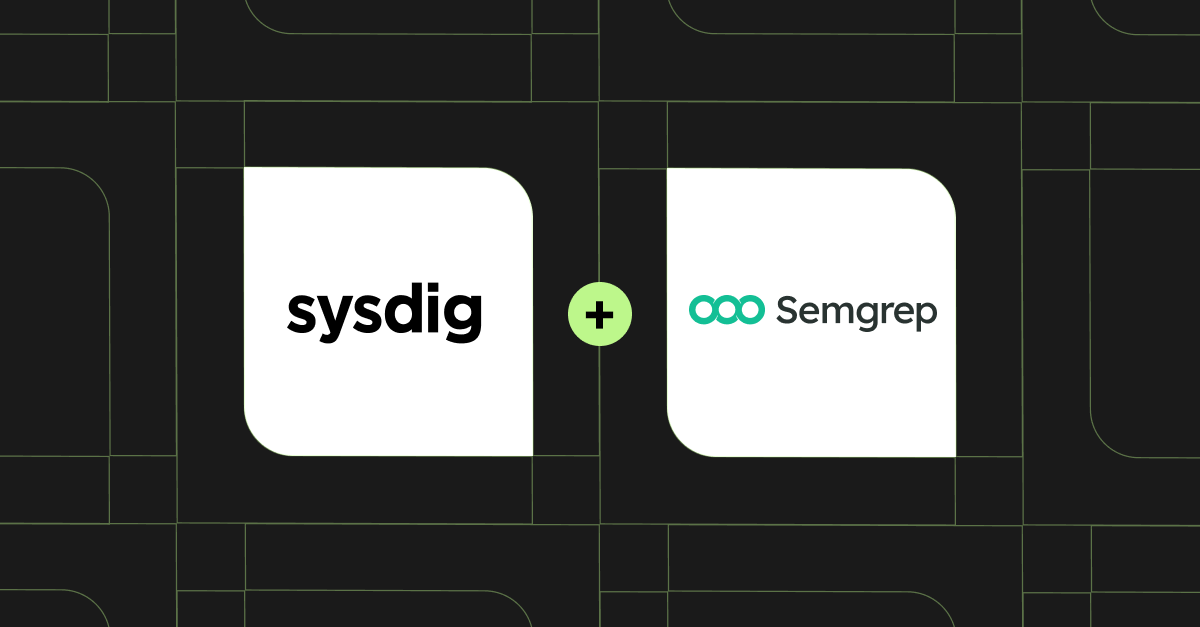
Falco Feeds extends the power of Falco by giving open source-focused companies access to expert-written rules that are continuously updated as new threats are discovered.

Today, every minute counts as security teams are being asked to do more with greater urgency, fewer resources, and increasingly complex cloud environments. That pressure is compounded by a persistent challenge: even when security finds something critical, how do you help the right development team fix it — fast?
At Sysdig, we believe that runtime visibility is essential, but not enough on its own. That’s why we’ve partnered with Semgrep, a leader in build-time and developer-centric security, to deliver unified Code to Cloud security. Together, we’re giving security teams what they’ve always needed: the ability to trace runtime threats directly to their source in code and deliver actionable insights to the teams who can resolve them quickly and confidently.
Bridging runtime and build-time with bi-directional context
Until now, runtime and static application security findings lived in silos.. Your SOC might flag a vulnerability running in production, but chasing down the right fix — the code, the file, the owner could take days. On the flip side, build-time findings from SAST or SCA scans often lacked the context and prioritization needed to better understand which issues were actually exploitable in production.
That’s where this partnership makes a difference.
By integrating Sysdig’s runtime threat detection and posture insights with Semgrep’s static analysis and software composition analysis (SCA), we’re connecting the dots between what’s exploitable now and where it originated in your codebase.
This means you can:
- Trace runtime alerts back to specific packages, files, and repos
- Connect vulnerable code to the owning developer
- Prioritize static findings with runtime context
- Recommend precise package upgrades to fix vulnerabilities at the source
Other customer outcomes from this partnership include:
Pinpoint the root cause, not just the symptom
With the combined strength of Sysdig and Semgrep, security teams no longer stop at detection; they can now explain exactly where an issue came from, and who can fix it. When a risk is uncovered in production, you're not just flagging “something is wrong” — you're identifying the repository, the team, and the code path that introduced the problem.
Instead of chasing down information across multiple tools and teams, you're delivering answers — fast.
This gives security leaders the context and confidence to prioritize effectively and helps developers understand how their code affects real-world risk.
Deliver fixes that are ready to act on
Security findings without action plans are just noise. This integration gives you the ability to provide developers and application teams with specific, trusted fix recommendations like which package version is safe or where a known vulnerability can be patched.
You're not just assigning issues; you're empowering teams with the clarity and direction to resolve them.
That’s the difference between pointing out problems and truly enabling resolution.
Build a bridge between security and development
Most importantly, this integration helps you become a better partner to both your dev and app teams. By combining Sysdig’s runtime insights with Semgrep’s code and ownership context, you’re now speaking their language: pointing to actual files, relevant commits, and prioritized risks — not abstract alerts.
Instead of throwing findings over the wall, you’re collaborating with the people who can resolve them.
That alignment reduces friction, boosts efficiency, and builds a security culture rooted in a trusted and collaborative partnership, not oversight.
Security without silos
The real benefit isn't just in the technical enrichment, it's in how it changes team dynamics.
- Security operations gain deeper insight and higher signal-to-noise ratios.
- Application teams receive targeted alerts with clear, fixable paths.
- Cross-functional workflows improve with a shared language of ownership, risk, and remediation.
By giving everyone access to a unified signal, the partnership between Sysdig and Semgrep helps organizations move from security bottlenecks to secure velocity.
The Sysdig advantage: Delivering cloud security, the right way — together with Semgrep
For too long, security in the cloud has been built around compromise.
Teams are told that noisy alerts, fragmented tools, and siloed workflows are just “the cost of doing business.” That it’s okay to ship static findings without knowing if they’re exploitable, or to flood developers with issues they can’t act on. This is what “good enough” security looks like, and it’s no longer good enough.
Together with Semgrep, Sysdig is empowering security teams to redefine what success looks like and finally deliver cloud security the right way.
This isn’t just another integration. It’s a shared belief and mindset that security should enable speed, not slow it down. That context beats coverage. And that when runtime and build-time insights come together, teams don’t just detect risk, they fix what matters.
Together, Sysdig and Semgrep are leading the way, bringing together code and cloud visibility so teams can reduce noise and fix what matters.


